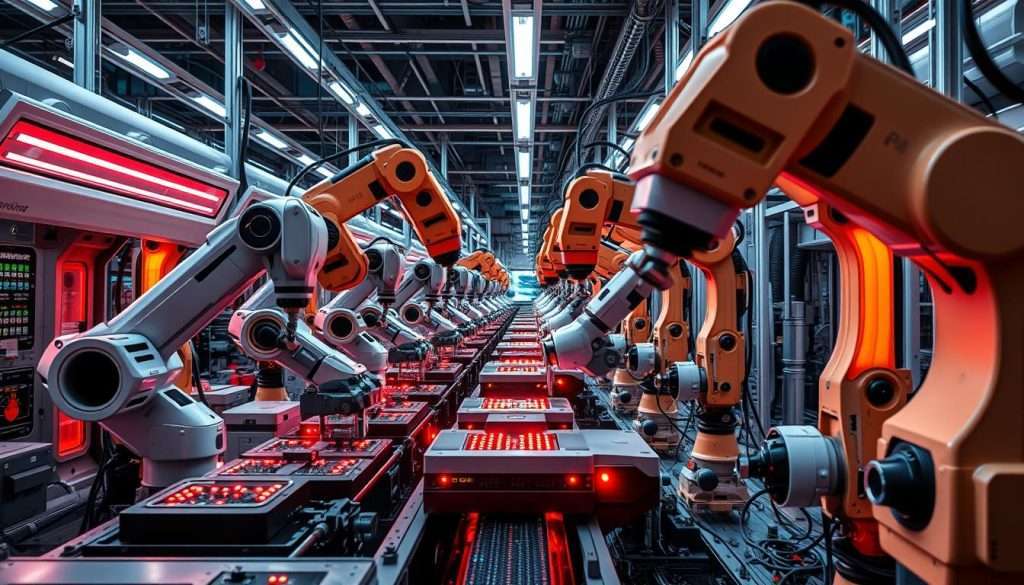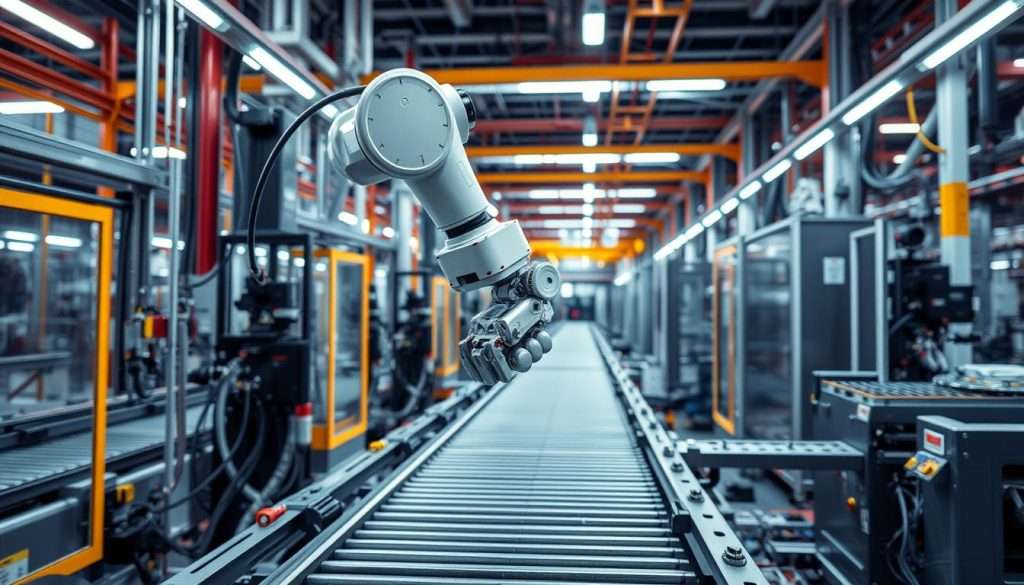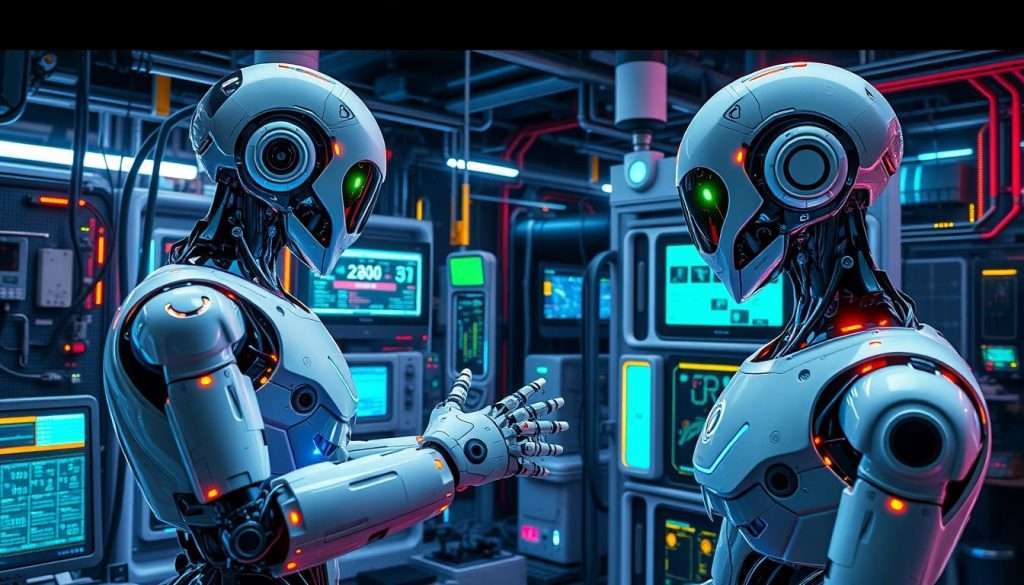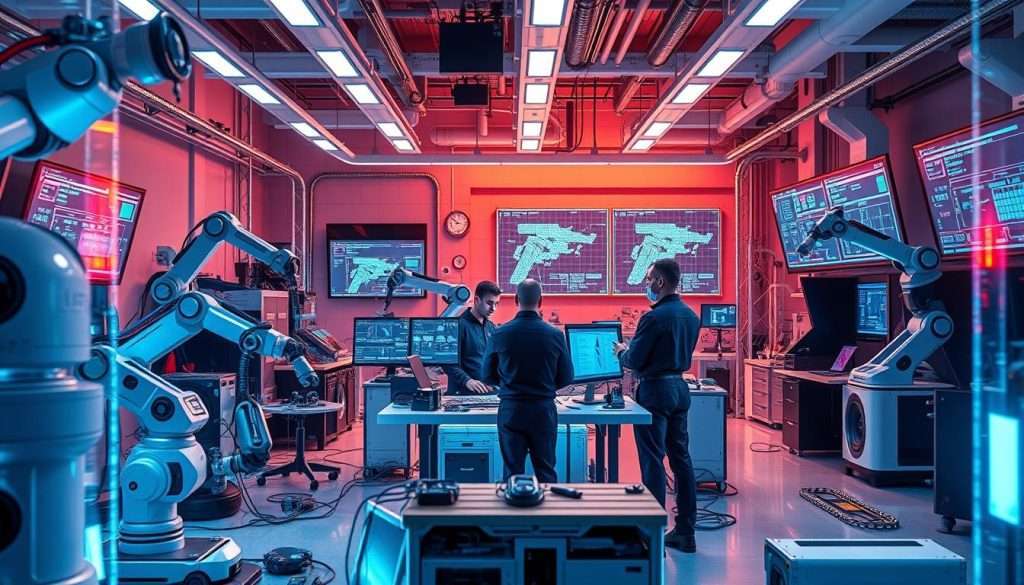Robotics has changed the game in modern tech. It’s making industries like manufacturing, healthcare, and space better. Robots are now key in making things faster, more accurate, and more efficient.
Robots use electronics, computing, and AI to do amazing things. They can sense, process info, and do complex tasks with great precision.
Robotics has made huge leaps forward. Industrial robots are now a big part of making things. They do jobs like assembly, welding, and painting fast and well.
Service robots are changing how we interact with them. They help in healthcare, hospitality, and customer service. They offer care, cleaning, delivery, and even friendship.

Key Takeaways:
- Robotics technology has transformed various industries, enhancing efficiency, accuracy, and productivity.
- The integration of robotics with artificial intelligence and automation solutions is revolutionizing manufacturing, healthcare, and other sectors.
- Advancements in robotics are enabling sophisticated systems capable of sensing, processing information, and performing complex tasks with precision.
- Industrial robots are extensively used in manufacturing, while service robots are interacting with humans in healthcare, hospitality, and customer service.
- The future of robotics holds immense potential for continued innovation and transformative change across industries.
Understanding the Evolution of Modern Robotics
Robots have been around since ancient times. They started with simple machines and automated systems. But, the 20th century brought big changes with computers and artificial intelligence (AI).
Origins and Historical Development
The word “robot” comes from the Czech word “robot,” meaning “forced labor.” It was first used in a 1920 play by Karel Čapek. The first mobile robot, ELSIE, was made in England in the 1950s.
Then, robots got better with things like tactile sensors and vision cameras. Robots like SHAKEY from Stanford Research Institute in the 1960s were a big step forward.
Key Milestones in Robotics Innovation
The 1980s and 1990s saw robots become common in factories. This was true in the U.S., Europe, and Asia, especially Japan and Sweden. Robots with arms helped make things safer and more efficient on assembly lines in the 1980s.
In the 1990s, robots got smarter with better computer vision and machine learning. This let them do more complex tasks and adapt to different places.
Foundational Technologies Behind Modern Robots
Robots have gotten better thanks to better electronics, computers, and learning machines. Artificial intelligence has made robots more accurate and able to make decisions on their own. This has made robots a big part of our daily lives, like in vacuum cleaners and smart homes.
| Year | Milestone |
|---|---|
| 1954 | Unimate, the first industrial robot, designed by George Devol, revolutionized assembly lines. |
| 1961 | The Unimate, the first industrial robot, was installed in a General Motors assembly line, marking a significant milestone. |
| 1970s | Shakey, the first mobile robot capable of reasoning about its actions, was developed at Stanford University. |
| 1980s-1990s | Industrial robots were widely adopted in manufacturing, improving efficiency and safety. |
| 1990s | Advancements in computer vision and machine learning enhanced robot capabilities to perform complex tasks. |
Robotics is still growing, with AI, machine learning, and quantum computing leading the way. These advancements promise robots that can do even more on their own. Robotics has changed many fields, from making things to helping in healthcare. It’s changing how we live and work.
Core Components of Robotics Technology
Robotic technology has many parts that work together. These parts include mechanical parts, power sources, sensors, control systems, and software. They help industrial, service, and humanoid robots do their jobs well.
At the center of a robot is its mechanical body. It has joints, limbs, and end-effectors for movement and interaction. Robots also need power, like rechargeable batteries or wired connections, to work.
Sensors are key for robots to see and understand their world. Vision sensors help recognize objects and sort them. Proximity sensors prevent crashes, and special sensors check temperature and pressure.
The control system is a robot’s brain. It uses sensor data, executes commands, and adapts to changes. Advanced software and algorithms make robots smart and able to make decisions on their own.
Actuators, like electric motors, give robots the power to move and interact. They let robots handle objects, move around, and work with humans and machines.
Navigation and mapping tech, like LiDAR and SLAM, help robots move safely and efficiently. Communication systems let robots talk to humans and other devices easily.
By combining these parts, robotics has changed many industries. It has improved manufacturing, logistics, healthcare, and more. As robotics gets better, we’ll see even more innovation and new ways for humans and robots to work together.

“The integration of sophisticated robotic components, from sensors and actuators to control systems and communication technologies, is the foundation that enables robots to perform complex tasks with precision, efficiency, and adaptability.”
Types of Industrial and Commercial Robots
The robotics and automation world has changed a lot. It now changes how businesses work. Robots are everywhere, making things better and faster. There are many types of robots, each for different jobs.
Manufacturing and Assembly Robots
Industrial robots are key in making things. They do jobs like welding and putting parts together. They are faster and more accurate than people.
Robots like the Unimate from 1948 help a lot. They are used in cars, electronics, and planes. This shows how robots keep getting better.
Service and Healthcare Robots
Robots are not just for making things. They help in service and healthcare too. They do things like clean and help with surgeries. They even help the elderly and disabled.
The demand for these robots is growing. It’s expected to reach $33.8 billion in 10 years. This shows how much people need them.
Autonomous Mobile Robots
Autonomous mobile robots (AMRs) are new and exciting. They move on their own, without needing people to tell them what to do. They are used in places like warehouses and farms.
AMRs make things run smoother. They help with moving things around. The market for these robots is growing fast, thanks to new tech.
Robots are changing how we do things. They make work better, safer, and more efficient. As tech gets better, we’ll see more robots in different places.
| Type of Robot | Key Applications | Market Outlook |
|---|---|---|
| Manufacturing and Assembly Robots | Welding, material handling, precision assembly | The Delta robots market forecasted to increase by $1.41 billion between 2024 and 2028 |
| Service and Healthcare Robots | Hospitality, customer service, surgery, diagnostics, caregiving | Spending on robotics by companies is expected to reach nearly $66.9 billion by 2025 |
| Autonomous Mobile Robots | Logistics, warehousing, agriculture | Delta robots market forecasted to increase by $1.41 billion between 2024 and 2028 |
Artificial Intelligence and Machine Learning Integration
The mix of artificial intelligence and machine learning has changed robotics a lot. Now, robots can act more like humans and work better with us. These new techs help robots see, talk, and learn in new ways.
Computer vision and object recognition let robots pick up things with great skill. Machine learning makes them get better with time. Motion control and autonomous navigation help robots move around and do tasks well.
Natural language processing makes robots understand and talk back in our language. This makes working with robots easier and opens up new chances in many fields.
“The use of artificial intelligence in robots started in the 2000s. It has made big changes worldwide.”
AI and machine learning have big effects on robotics. They help in making, health care, and moving things around. These techs make robots work better and open up new areas for working together with machines.

As artificial intelligence and machine learning keep getting better, robotics’ future looks bright. It could change many industries and how we work and live.
Applications Across Different Industries
Robotic technology has changed many industries. It helps businesses work better and come up with new ideas. It’s used in making things, healthcare, and even space exploration.
Manufacturing and Production
In making things, robots play a big role. They make things faster, better, and more consistent. They do tasks that are hard or dangerous for people.
Robots are used for welding, moving things around, and even putting parts together. This makes making things a lot easier.
Healthcare and Medical Procedures
Service robots are changing healthcare a lot. They help with surgeries, making them less invasive. This means patients heal faster.
Robots also help with physical therapy and care for the elderly. They make life better for older people and help healthcare workers too.
Space Exploration and Research
Robotic technology has helped a lot in space. Robots explore places like the ocean and Mars. They send back important information.
This helps us learn more about our world and the universe. It’s a big step forward in space research.
Robotics is used in many areas, not just these. It’s also used in farming, moving things around, in the military, and even in shows. As technology gets better, robotics will keep changing many fields.
Impact on the Modern Workforce
The mix of robotics engineering and artificial intelligence robotics is changing jobs. It brings both good and bad for today’s workers. Some jobs might go away, but new ones will come up in robot design and more.
Cobots, or collaborative robots, are a great example. They help humans by doing hard, boring tasks. This lets people do more important and creative work.
More robotics engineering and artificial intelligence robotics mean workers need to learn new things. They must get better at tech skills to keep up in the job world.
| Robotics Adoption Rate | Impact on Employment |
|---|---|
| 1 robot per 1,000 workers in the U.S. | Wages decline by 0.42%, employment-to-population ratio decreases by 0.2 percentage points, resulting in the loss of about 400,000 jobs |
| 1 robot added in a commuting zone | Reduces employment by 6 workers in that area |
| Fourfold increase in industrial robots in the U.S. between 1993 and 2007 | Reduced the average employment-to-population ratio by 0.39 percentage points and average wages by 0.77% |
The effect of automation on jobs is complex. It needs work from everyone to solve problems and share the good parts of new tech.

Challenges and Safety Considerations
The fast growth in robotics technology brings big challenges and safety worries. This is because of advances in artificial intelligence and automation. It’s key to know the tech limits, ethics, and security risks of these new techs.
Technical Limitations and Solutions
Robots need better artificial intelligence to deal with tough and changing situations. Today’s robots often find it hard to adapt, make decisions, and handle dynamic scenes. Researchers are working hard to improve robots’ perception, reasoning, and learning. This will make robots more useful and flexible.
Ethical Considerations
Robots taking jobs raises big ethical questions. People worry about job loss and its effect on work. Also, how robots make choices is being questioned. There are worries about who is responsible and what rules should guide robots.
Creating clear rules and laws is needed to use robots right and fairly.
Security and Privacy Concerns
Robots sharing data makes security and privacy big issues. If robots are hacked, data can be stolen. It’s vital to have strong security like encryption and monitoring to keep robots and data safe.
Keeping workers and the public safe is very important as robotics technology grows. We need to keep working on tech, ethics, and security. This will help robots help us while keeping everyone safe.
| Safety Concern | Description | Mitigation Strategies |
|---|---|---|
| Struck-by Hazards | Hazards involving forceful impact from moving robots, components, or objects in the workspace | Physical barriers, presence-sensing devices, safe distancing, and thorough worker training |
| Caught, Crushing, and Trapping Hazards | Risks of being compressed between objects or robot components | Safety circuit integration, emergency stops, lockout/tagout procedures, and worker training |
| Hydraulic Hazards | Risks associated with hydraulic fluid leaks, high pressure, and potential flammability | Leak prevention, protective gear, fire safety measures, and regular maintenance |
| Electrical Hazards | Risks of arc flashes, shocks, fires, and burns | Proper grounding, lockout/tagout procedures, protective gear, and regular maintenance |
| Pneumatic Hazards | Risks of high-speed object launches due to powerful air pressure | Pressure regulators, secure fastenings, and worker training |
| Slip, Trip, and Fall Hazards | Hazards caused by unsecured cables, inadequate lighting, debris, or spills | Proper housekeeping, adequate lighting, secure cables and hoses, and appropriate PPE |
| Environmental Hazards | Exposure to harmful substances, extreme temperatures, noise, and other risks | Proper ventilation, hazard labeling, appropriate PPE, and thorough risk assessments |
“The establishment of the National Institute for Occupational Safety and Health (NIOSH) Center for Occupational Robotic Research aims to enhance safety practices when working with robots by providing a better understanding of the associated risks and benefits.”
Future Trends and Innovations
The future of robotics technology is exciting. Advances in artificial intelligence and sensors are changing what robots can do. Soft robotics and swarm robotics are leading the way in automation.
Robots are now working with 5G, edge computing, and the Internet of Things. This mix is opening up new uses and growing the robotics field. For example, “MoMas” robots are helping in car, logistics, and aerospace industries.
New materials and energy storage are making robots better. Soft robotics, in particular, is big. It lets robots work like humans, making them great for healthcare and more.
Robots and humans are working together more. Better sensors and vision tech are making this possible. Robots are helping in healthcare, from surgery to making tools to fight the pandemic.
Swarm robotics is also on the rise. It’s inspired by social insects and is good for monitoring, farming, and logistics. This new way of automating is solving complex problems.
The robotics and automation world is always changing. New tech and smart solutions are leading to more progress. This is shaping the future of robotics.

Conclusion
Robotics technology is changing the world. It solves big problems and opens new doors for innovation. It’s used in many areas, like making things, helping in healthcare, teaching, and moving goods.
Robots are getting smarter thanks to artificial intelligence and machine learning. They can do many tasks well. This makes work better, saves money, and makes life easier for everyone.
But, there are still challenges like technical issues, ethics, and safety. Yet, the good things robots can do are huge. They help solve big problems and make the economy grow. Robotics is key for making things better and pushing what we can do.
FAQ
What is robotics technology?
Robotics technology mixes electronics, computing, and AI. It makes systems that can sense, process info, and do complex tasks. It has changed many industries, making things more efficient and accurate.
What are the origins and historical development of modern robotics?
Robotics started long ago with simple machines and systems. Big steps in the 20th century, like computers and AI, helped create today’s robots.
What are the key components of robotics technology?
Robotics has mechanical parts, electric power, and programming software. Sensors, actuators, control systems, and AI are key. They help robots work on their own or with some human help.
What are the different types of industrial and commercial robots?
Industrial robots do tasks like assembly and welding in factories. Service robots help in healthcare and hospitality. They do things like caregiving and cleaning. Autonomous robots work alone, like in exploration and farming.
How is artificial intelligence and machine learning transforming robotics?
AI and machine learning are changing robotics. They make robots work better with people. Robots can now do things like see and move like humans. They can even talk and understand language.
What are the diverse applications of robotics technology?
Robotics is used in many fields, like making things, healthcare, space, farming, and more. It has created new jobs in designing, programming, and caring for robots.
What are the challenges and safety considerations in the integration of robotics technology?
There are many challenges, like technical limits and safety. We also need to think about ethics and security. We must keep working on these issues to make robotics safe and responsible.
What are the future trends and innovations in robotics technology?
Robotics is getting even better, with new AI and sensor tech. It will connect with 5G, edge computing, and the Internet of Things. We’ll see soft robots, more swarm robots, and robots in smart cities and homes.
